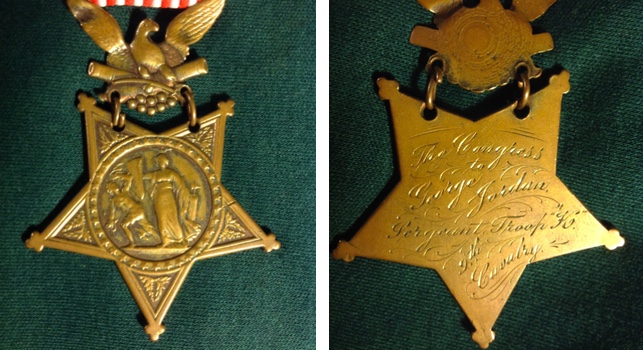All We Had of this Black Hero Soldier Was a Picture, and then Something Else Turned Up

The faded faces look back at you from the past. An old photograph taken in 1890s Nebraska showing the U.S. Army’s 9th Cavalry’s K Troop or, as they were better known, buffalo soldiers. One of my journalistic quests for the last two decades has been the search for any personal effects belonging to the soldier seated third from the left. The man under that hat is Medal of Honor recipient First Sergeant George Jordan, USA. He also held a Certificate of Merit – the two highest commendations a U.S. soldier could receive in his era.
Jordan was born in 1847 in Williamson County, Tennessee enlisting in the Army six months after President Andrew Johnson signed the 1866 bill allowing African Americans to serve in the post-Civil War Army. Jordan educated himself learning how to read and write and joined K Troop four years later, where he remained throughout his career – proving to be one of the best field commanders in the Army west of the Mississippi. No one buffalo soldier epitomized their motto, “We can. We will,” as well as he did, going against the most skilled guerilla fighters in the world under the leadership of Apache chiefs Victorio and Nana. The white officers in charge of the all-black units often trusted Jordan with half of their commands because of knowledge and skill in the field.
Jordan got a raw deal in the end. His retirement pension provided enough for a small home in nearby Crawford, Nebraska, where other former buffalo soldiers made a community. He did well there, but fell sick years later. His doctor twice sought to admit him to Fort Robinson Hospital, but he was refused treatment and told to try the soldier’s home in Washington, DC. His race was said to have played a part in the decision.
He died October 14, 1904, from what the post chaplain said was “want of proper attention and living alone where he had no one to attend his wants.” The entire fort turned out for his funeral and Jordan was buried with full military honors. Fort Robinson’s Hospital’s inaction brought national rebuke from the Surgeon General regarding the medical treatment of retired veterans. Then all traces of his life vanished. A headstone, a bureaucratic record of military awards in D.C., and that faded group photo is all the nation possesses of such a legendary life as his.
Journalists do odd things between jobs to stay employable. In 1996 mine was helping a museum locate artifacts and decorate the unmarked graves of Tennessee’s Medal of Honor recipients. This cross-country effort was where I first learned of Jordan. When researching a newspaper feature on him later at a new job, I spoke with then-Joint Chiefs Historian and author Frank Schubert, who’s considered the foremost authority on buffalo soldiers. Much was learned, but no trail leading to any physical evidence of this old west icon’s life other than that single faded photograph.
Years of scanning estate auctions followed, as did sharing his photo and story when possible, dropping his name in columns on black history, and in documentaries I produced – featuring him prominently in one on Tennessee’s military legacy. It was all in the hope that some personal item would shake loose that spoke to his 30 years of dedicated service.
On March 3, it was the farthest thing from my mind when I signed into a social media account to find a message from Arkansas historian Kim Nazario, who had found me through one of those efforts and sent me two images. The face of a ribbon-less Civil War Era Medal of Honor and its reverse side bearing the inscription: “The Congress to George Jordan, Sergeant, Troop K, Ninth Cavalry.”

What followed was a flurry of calls between Nazario, myself, and the owner Janet Mize, establishing the provenience of the items and the back story on how Jordan’s effects, including his Medal of Honor (which was believed to have been buried with him) had found their way to Arkansas.
Jordan’s personal effects were placed in a barrel by his friends after he died and deposited with the Army to hold for his next of kin. None ever showed and around 1909 a ranch manager’s widow in Nebraska bought the barrel at auction for $1. It was passed to her schoolteacher daughters who never married and then willed their possessions to their caretaker Janet Mize, who later moved to Arkansas.
Mize said during the time the sisters possessed the barrel, most of the old photos of black soldiers, personal items, and Jordan’s military accoutrements got parceled out. The Medal of Honor itself was saved only by the shining brass that made it a useful Christmas tree decoration in a historic home. Hundreds of people passed by it for years never noticing what it was. It and a few simple items are all that remain in the possession of Mize. Talks are now underway to find a suitable venue to display these relics from one of America’s forgotten frontier legends.